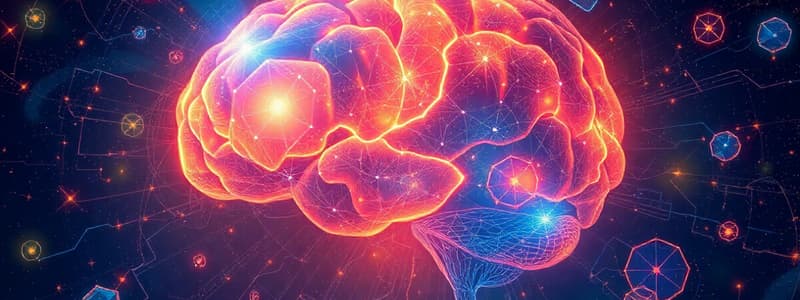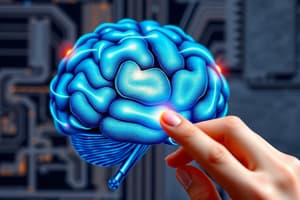Podcast
Questions and Answers
Which level of analysis focuses on the function and purpose of cognitive processes?
Which level of analysis focuses on the function and purpose of cognitive processes?
- Functional level (correct)
- Processing level
- Hardware level
- Algorithm and Computation level
Higher reaction times indicate faster automatic processing of information.
Higher reaction times indicate faster automatic processing of information.
False (B)
What method involves analyzing a participant's verbalizations during problem-solving?
What method involves analyzing a participant's verbalizations during problem-solving?
Verbal Protocols
The _____ level examines how algorithms and computations are physically implemented.
The _____ level examines how algorithms and computations are physically implemented.
Match the following methods of measuring information processing to their descriptions:
Match the following methods of measuring information processing to their descriptions:
What is the primary focus of the Algorithm and Computation level?
What is the primary focus of the Algorithm and Computation level?
Eye tracking can provide insights into patterns of observation focused by subjects.
Eye tracking can provide insights into patterns of observation focused by subjects.
____ measures the number and type of errors a participant makes during recall.
____ measures the number and type of errors a participant makes during recall.
Which type of memory is associated with personal experiences?
Which type of memory is associated with personal experiences?
Automatic processing requires a high amount of attention.
Automatic processing requires a high amount of attention.
Describe the Stroop Effect in your own words.
Describe the Stroop Effect in your own words.
The two types of cognitive processes that involve the use of prior information are _____ processes and _____ processes.
The two types of cognitive processes that involve the use of prior information are _____ processes and _____ processes.
Match the cognitive processes with their definitions:
Match the cognitive processes with their definitions:
What does the global processing perspective focus on?
What does the global processing perspective focus on?
Parallel processing allows for multiple cognitive processes to operate simultaneously.
Parallel processing allows for multiple cognitive processes to operate simultaneously.
Explain the role of suppression in the Stroop task.
Explain the role of suppression in the Stroop task.
What is the primary purpose of the Wisconsin Card Sort Task?
What is the primary purpose of the Wisconsin Card Sort Task?
The process of priming can influence cognitive processes without conscious awareness.
The process of priming can influence cognitive processes without conscious awareness.
What term describes the relationship between specific brain regions and their functions?
What term describes the relationship between specific brain regions and their functions?
The principle of ______ indicates that the receptor and control centers for one side of the body are in the opposite hemisphere of the brain.
The principle of ______ indicates that the receptor and control centers for one side of the body are in the opposite hemisphere of the brain.
Match the following brain functions to their corresponding hemisphere:
Match the following brain functions to their corresponding hemisphere:
Which of the following approaches focuses on the behaviors of patients with unique brain damage?
Which of the following approaches focuses on the behaviors of patients with unique brain damage?
Hemispheric specialization suggests that specific cognitive functions rely equally on both brain hemispheres.
Hemispheric specialization suggests that specific cognitive functions rely equally on both brain hemispheres.
What does priming involve in the context of cognitive processes?
What does priming involve in the context of cognitive processes?
Which brain imaging method primarily focuses on measuring electrical activity?
Which brain imaging method primarily focuses on measuring electrical activity?
Functional Magnetic Resonance Imaging (fMRI) provides excellent timing information of cognitive processes.
Functional Magnetic Resonance Imaging (fMRI) provides excellent timing information of cognitive processes.
What is the primary function of the occipital lobes?
What is the primary function of the occipital lobes?
The ___________ lobes are involved in integrating information from the world and contain the somatosensory cortex.
The ___________ lobes are involved in integrating information from the world and contain the somatosensory cortex.
Match the imaging methods to their primary functions:
Match the imaging methods to their primary functions:
What technique uses a powerful magnetic field to inactivate patches of neurons?
What technique uses a powerful magnetic field to inactivate patches of neurons?
The subtraction method in brain mapping involves taking the average of baseline and experimental tasks.
The subtraction method in brain mapping involves taking the average of baseline and experimental tasks.
What does Event Related Potential (ERP) highlight in cognitive processing?
What does Event Related Potential (ERP) highlight in cognitive processing?
Flashcards
Attention
Attention
The ability to focus on specific information while ignoring distractions.
Limited Resources or Capacity
Limited Resources or Capacity
Our mental capacity to hold and process information is limited.
Multiple Levels and Types of Memory Storage
Multiple Levels and Types of Memory Storage
Short-term memory (STM) holds information temporarily, while long-term memory (LTM) stores information for extended periods.
Semantic Memory
Semantic Memory
Signup and view all the flashcards
Episodic Memory
Episodic Memory
Signup and view all the flashcards
Procedural Memory
Procedural Memory
Signup and view all the flashcards
Automatic Processing
Automatic Processing
Signup and view all the flashcards
Conscious Processing
Conscious Processing
Signup and view all the flashcards
Functional Level
Functional Level
Signup and view all the flashcards
Algorithm and Computation Level
Algorithm and Computation Level
Signup and view all the flashcards
Hardware Level
Hardware Level
Signup and view all the flashcards
Reaction Time (RT)
Reaction Time (RT)
Signup and view all the flashcards
Reading Times
Reading Times
Signup and view all the flashcards
Verbal Protocols
Verbal Protocols
Signup and view all the flashcards
Preference Method
Preference Method
Signup and view all the flashcards
Eye Tracking
Eye Tracking
Signup and view all the flashcards
Electroencephalogram (EEG)
Electroencephalogram (EEG)
Signup and view all the flashcards
Event-Related Potential (ERP)
Event-Related Potential (ERP)
Signup and view all the flashcards
Positron Emission Tomography (PET) SCAN
Positron Emission Tomography (PET) SCAN
Signup and view all the flashcards
Functional Magnetic Resonance Imaging (fMRI)
Functional Magnetic Resonance Imaging (fMRI)
Signup and view all the flashcards
Transcranial Magnetic Stimulation (TMS)
Transcranial Magnetic Stimulation (TMS)
Signup and view all the flashcards
Occipital Lobes
Occipital Lobes
Signup and view all the flashcards
Parietal Lobes
Parietal Lobes
Signup and view all the flashcards
Somatosensory Cortex
Somatosensory Cortex
Signup and view all the flashcards
Study Notes
Cognitive Science Approach
- Key Themes: Attention (focused, selective, multitasking, limited resources), multiple types of memory (STM, LTM, semantic, episodic, procedural), interactions between memory types for learning, reasoning, problem-solving, and intelligence.
- Representation, Organization, and Categorization: Organizing information in memory.
- Automatic Processing: Information processed quickly, without awareness, and doesn't require much attention.
- Conscious Processing: Deliberate processing of information with awareness; requires attention.
- Information Processing Approach: Cognition and learning emerge from coordinated mental processes in a multi-component memory system.
- Automatic Processes: Allow efficient "autopilot" mental operations, but lack flexibility.
- Bottom-up Processes: Driven by immediate, available environmental information.
- Top-down Processes: Rooted in prior knowledge, preconceptions, and expectations.
Stroop Effect
- Definition: Automatic process of reading interferes with controlled process of naming the color of a word (e.g., the word "red" printed in blue).
- Successful Performance: Requires suppressing automatic processes.
Information Processing
- Global (Gestalt): Processing the bigger picture.
- Local (Focused/Detailed): Processing smaller details.
- Parallel Processing: Multiple cognitive processes occurring simultaneously for enhanced efficiency.
Levels of Analysis (Marr, 1982)
- Functional Level: The goal of the computations and the function/purpose of the cognitive processes, including information inputs and behavioral outputs.
Measuring Information Processing
- Reaction Time (RT): Time elapsed between stimulus presentation and response.
- Reading Times: Time taken to read sentences or passages.
- Verbal Protocols: Descriptions of participants' thought processes during problem-solving.
- Preference Method: Choosing between competing or available stimuli.
- Eye Tracking: Measuring gaze or eye movements.
- Accuracy Measures: Evaluating the number and type of errors (e.g., omissions, incorrect responses).
Wisconsin Card Sorting Task
- Description: Task involving sorting cards based on color, number, and shape with changing sorting rules.
- Purpose: Evaluating performance in the face of changing rules.
Priming
- Definition: Initially presented stimulus influencing later cognitive processes.
- Examples: Activation of automatic unconscious processes.
Neurocognition
- Brain Function Principles: Specific areas of the brain perform specialized functions, processing information efficiently.
- Contralaterality: Receptors and control centers for one body side are in the opposite brain hemisphere.
- Hemispheric Specialization: Different brain functions rely more heavily on one hemisphere (e.g., language in the left hemisphere for right-handed individuals).
- Cognitive Neuropsychology: Studying behavior and high-level cognitive processes in individuals with brain damage to examine brain function.
- Cognitive Neuroscience: Manipulating stimuli in experiments and using brain imaging to understand cognitive processes.
- Mapping the Living Brain: Methods for understanding brain activity during cognitive tasks (e.g., EEG, ERP, fMRI).
- Functional Magnetic Resonance Imaging (fMRI): Measuring brain activity based on blood flow.
Brain Lobes
- Occipital Lobes: Processing visual information (eyes).
- Parietal Lobes: Integrating sensory information (skin), spatial representation.
- Temporal Lobes: Processing auditory information, memories, and emotions (ears).
- Frontal Lobes: Initiating voluntary movements, short-term memory, planning, and higher-level cognitive functions (limbs).
- Prefrontal Cortex: Higher-level thinking.
Studying That Suits You
Use AI to generate personalized quizzes and flashcards to suit your learning preferences.




